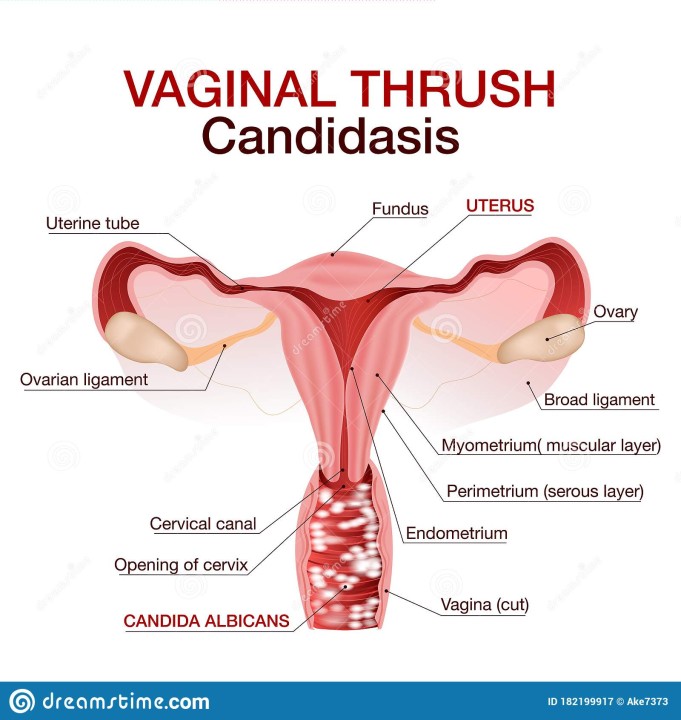
Vaginal Candidiasis
Vaginal Candidiasis
Candidiasis is an infection caused by a yeast (a type of fungus) called Candida. Candida normally lives insides the body (in places such as the mouth, throat, gut and vagina) and on skin without causing any problems. Sometimes Candida can multiply and cause an infection if the environment inside the vagina changes in a way that encourages its growth. Candidiasis in the vagina is commonly called a “vaginal yeast infection.” Other names for this infection are “vaginal candidiasis,” “vulvovaginal candidiasis,” or “ candidal vaginitis.”
Causes
- Taken antibiotic medication that’s treating an infection of any type- a urinary tract infection (UTI) is one of the example. While treating this this infection, good bacteria in the vagina is killed. This good bacteria was responsible for keeping the yeast in check. Without it, the balance is thrown off, leading to yeast infection.
- During pregnancy and while using hormonal contraceptives (birth control). Rising and change hormones during this time can disrupt the balance of candida in the vagina.
- Diabetes is one of the condition where there is too much sugar in your urine and the vagina is impacted by this surplus of sugar.
- Weakened immune system such as HIV or AIDS, then the medications can suppress immune system.
- Sexual activity - vaginal yeast infections are not a sexually transmitted infection. They can occur in women who are sexually active.
Symptoms
The symptoms of vaginal candidiasis include:
- Vaginal itching or soreness
- Pain during sexual intercourse
- Pain or discomfort when urinating
- Abnormal vaginal discharge
- Although most vaginal candidiasis is mild, some women can develop severe infections involving rednes, swelling, and cracks in the wall of the vagina.
Diagnosis
Swab will taken from the vagina to get the sample of discharge, which will be examined under a microscope in a lab. Treatment will given once the diagnosis was confirmed.Most vaginal yeast infections are caused by a fumgus called Candida albicans. Persistent or recurrent infections may be due to infection with one of the less common species of Candida, such as Candida glabrata or Cnadida krusei.
In women with recurrent or persistent symptoms, vaginal cultures should always be obtained to confirm the diagnosis and identify these less common species, if present, since different medications are used to treat these infections.
Treatment
Treatment may include a pill and from vagina
- Oral treatment - A prescription pill call fluconazole (sample brand name: Diflucan) is another option for treating yeast infections. Most women only need one dose, unles more complicated infections (such as those with underlying medical problems, recurrent yeast infections, or severe signs and symptoms) may require a second dose 72 hours (three days) after the first dose.
- Vaginal Treatment - Treatment for a vaginal often includes a vaginal cream or tablet. Application the cream or tablet inside the vagina at bedtime with an applicator. The length of treatment depends on how severe the infection is.
How to Prevent Vaginal Yeast Infections?
Make a few lifestyle changes. These changes can include:
- Not douching - douching can kill bacteria that actually controls fungus.
- Avoiding the use of feminine deodorants
- Not using deodorant (scented) tampons or pads.
- Changing out of wet clothing, especially bathing suits, as soon as you can.
- Using water - based sexual lubricants.
- Control blood sugar level as close to normal as possible can help to prevent vaginal yeast infections for those who have diabetes.
Vaginal Candidiasis Complications on Pregnant Women
- Low birth weight baby
- Prematurity
- After delivery it will risk factor of systemic infections in infant
- Candida dubliniensis can cause neonatal septicemia
References
Jack D Sobel, MD.(March,2022) “Patient Education: Vaginal Yeast Infection (Beyond the Basics).” UpToDate, https://www.uptodate.com/contents/vaginal-yeast-infection-beyond-the-basics/print.
Retreived on (19 April 2022) https://my.clevelandclinic.org/health/diseases/5019-yeast-infections#symptoms-and-causes
Rasti, S., Asadi, M. A., Taghriri, A., Behrashi, M., & Mousavie, G. (2014). Vaginal candidiasis complications on pregnant women. Jundishapur journal of microbiology, 7(2), e10078. https://doi.org/10.5812/jjm.10078